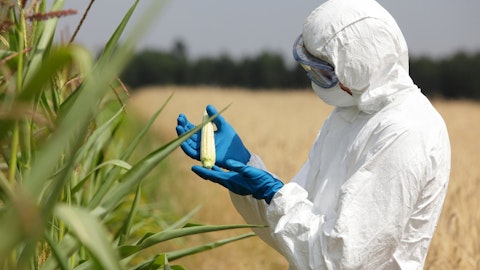Editas Medicine, Inc. (NASDAQ:EDIT) Q4 2023 Earnings Call Transcript February 28, 2024
Editas Medicine, Inc. beats earnings expectations. Reported EPS is $-0.23, expectations were $-0.52. EDIT isn’t one of the 30 most popular stocks among hedge funds at the end of the third quarter (see the details here).
Operator: Good morning, and welcome to Editas Medicine’s Fourth Quarter and Full Year 2023 Conference Call. All participants are now in listen-only mode. There will be a question-and-answer session at the end of this call. Please be advised that this call is being recorded at the company’s request. I would now like to turn the call over to Cristi Barnett, Corporate Communications and Investor Relations at Editas Medicine.
Cristi Barnett: Thank you, Maria. Good morning, everyone, and welcome to our fourth quarter and full year 2023 conference call. Earlier this morning, we issued a press release providing our financial results and recent corporate updates. A replay of today’s call will be available in the Investors section of our website approximately two hours after its completion. After our prepared remarks, we will open the call for Q&A. As a reminder, various remarks that we make during this call about the company’s future expectations, plans and prospects constitute forward-looking statements for the purposes of the Safe Harbor provisions under the Private Securities Litigation Reform Act of 1995. Actual results may differ materially from those indicated by these forward-looking statements as a result of various important factors, including those discussed in the Risk Factors section of our most recent Annual Report on Form 10-K, which is on file with the SEC as updated by our subsequent filings.
In addition, any forward-looking statements represent our views only as of today and should not be relied upon as representing our views as of any subsequent date. Except as required by law, we specifically disclaim any obligation to update or revise any forward-looking statements, even if our views change. Now, I will turn the call over to our CEO, Gilmore O’Neill.
Gilmore O’Neill: Thanks, Cristi, and good morning, everyone. Thank you for joining us today on Editas’s fourth quarter and full year 2023 earnings call. I am joined today by four other members of the Editas executive team, our Chief Medical Officer, Baisong Mei; our Chief Financial Officer, Erick Lucera; our Chief Scientific Officer, Linda Burkly; and our Chief Commercial and Strategy Officer, Caren Deardorf. We are pleased with Editas’ momentum and progress in the fourth quarter and all of 2023. In early 2023, we shared our vision and the three pillars of our strategy to position Editas as a leader in in vivo program for gene editing and hemoglobinopathies. The first of these pillars, to drive reni-cel, formerly known as EDIT-301, toward BLA and commercialization.
The second, to strengthen, reorganize, and focus our discovery organization to build an in vivo editing pipeline. And the third, to increase business development activities with a particular focus on monetizing our very strong IP. So how did we do last year? Well, we achieved a lot. First, we accelerated the clinical development of Reni-cel, exceeding our enrollment goal of 20 patients and sharing clinical updates from our RUBY and EdiTHAL studies in June and in December of 2023. And those accumulating data have strengthened our belief that reni-cel is a competitive potential medicine with a differentiated profile characterized by correction of anemia at normal physiologic ranges of hemoglobin. Second, we strengthened our in vivo discovery capabilities and organization and hired a new Chief Scientific Officer, Linda Burkly, who brings three decades of experience in successfully inventing, developing, and moving new human medicine forward.
And third, we increased our business development activities and monetized our IP, leveraging our robust IP portfolio. A critic example was our granting Vertex a non-exclusive license for our Cas9 IP in a focused way to enable the [XSL] launch. Finally, we strengthened our senior leadership team with people who have a proven track record in bringing new medicine through development to approval and commercialization. So how are we executed against these strategies and these objectives? Well, let’s start with Reni-cel. First, on enrollment, we have now enrolled 40 sickle cell and 9 beta thalassemia patients in our RUBY and EdiTHAL studies respectively, and enrollment continues at a good pace. Second, on dosing, we have dosed 18 RUBY patients and 7 EdiTHAL patients, and we have multiple patients scheduled for dosing in the coming month.
Patient screening and demand in both studies continue to remain robust. Third, on clinical data, we remain on track to present a substantive clinical data set of sickle cell patients with considerable clinical follow-up in the RUBY study in the middle of 2024, with a further update by year-end 2024. On the regulatory front, we have engaged with the FDA regarding the RUBY sickle cell trial. The FDA agrees that RUBY is a single Phase 1, 2, 3 study and has aligned with us on the study design. Our discussions with the FDA will continue as RUBY and EdiTHAL progress and will be enhanced by our RMAT designation for severe sickle cell disease. Baisong will share further details regarding the development of reni-cel in his remarks, as well as recap the RUBY and EdiTHAL takeaways and clinical data that we provided in December and share more information on the adolescent cohort.
Now, let’s turn to in vivo and our pipeline development, where we strengthened our in vivo discovery capabilities in 2023 and began lead discovery work on in vivo therapeutic targets in hematopoietic stem cells and other tissues. As we announced earlier this year, we aim to establish in vivo preclinical proof-of-concept for an undisclosed indication this year. Linda and her team are leveraging key capabilities that we have in-house and she looks forward to sharing more at a future date. Regarding our hemoglobinopathies focus, after a thorough evaluation of the development landscape, we have decided not to pursue internal development of a milder conditioning regime. We believe standalone milder conditioning regimens will be widely available once FDA approves and therefore we have determined that research, clinical development and regulatory investment in hemoglobinopathies can be better deployed for our continued development of in vivo HSE medicines.
Turning to business development. In the fourth quarter, we announced a licensed agreement with Vertex Pharmaceuticals. Editas provided Vertex a non-exclusive license for Editas Medicine’s Cas9 gene editing technology for ex vivo gene editing medicines targeting the BCL11A gene in the field of sickle cell disease and beta thalassemia, including Vertex’s CASGEVY. And the upfront and contingent payments pursuant to this agreement extended our cash runway into 2026. This and other agreements, the strength of our patents and the number of companies developing CRISPR/Cas9 medicine reaffirm our confidence that our IP portfolio of foundational U.S. and international patents covering Cas9 use in human medicine are a source of meaningful value. So what are our objectives for 2024?
For reni-cel, we will provide a clinical update from the RUBY trial for severe sickle cell disease and the EdiTHAL trial for transfusion-dependent beta thalassemia in mid-2024 and by year-end 2024. We will complete adult cohort enrollment and initiate the adolescent cohort in RUBY, which we’ve already initiated, and continue enrollment in EdiTHAL. For our in vivo pipeline, we will establish in vivo preclinical proof-of-concept for an undisclosed indication, and for PD, we will leverage our robust IP portfolio and business development to drive value and complement core gene editing technology capabilities. We are energized by our progress and execution in 2023. With our sharpened strategic focus, our world-class scientists and employees, and our keen drive in execution, we continue to build momentum to progress our strategy to deliver differentiated editing medicines to patients with serious genetic diseases.
Now, I will turn the call over to Baisong, our Chief Medical Officer.

Baisong Mei: Thank you, Gilmore. Good morning, everyone. Let’s talk about reni-cel, which is on the clinical development for severe sickle cell disease and transfusion-dependent beta thalassemia. As of today, in the RUBY trial for sickle cell disease, we have enrolled 40 patients and dosed18 patients. We have multiple patients scheduled for dosing in the coming month. We’re also pleased to announce that we have initiated adolescent cohort in the RUBY study, which is one of our 2024 objectives. The interest and demand are high, and adolescent patients have already started screening. In the EdiTHAL trial for transfusion-dependent beta thalassemia, to date, we have enrolled nine patients and dosed seven patients. As I shared earlier, I continue to visit our RUBY and EdiTHAL clinical trial sites and continuously speak with investigators.
I appreciate the enthusiasm and support from the investigators and study size. I’m pleased with the momentum of reni-cel in patient recruitment, apheresis, editing, and dosing in both studies. I’m excited to hear from the investigators that patients dosed with reni-cel have already seen positive changes in their lives. As Gilmore mentioned, we have aligned with FDA that RUBY clinical trial is now considered a Phase 1, 2, 3 trial for BLA finding. We have also aligned with FDA on the study design and endpoints, and the FDA has agreed to our activation of adolescent cohort. We look forward to future discussion with FDA and continued collaboration. Turning to clinical data, in December 2023, we shared safety and efficacy data from 17 patients, 11 RUBY patients, 6 EdiTHAL patients.
Once again, the data confirmed observation from our prior clinical readouts, including reni-cel driving early and robust correction of anemia to a normal physiological range of total hemoglobin in sickle cell patients. Reni-cel drove robust and sustained increase in fetal hemoglobin in excess of 40%. All RUBY sickle cell patients have remained free of vaso-occlusive events following reni-cel treatment. Reni-cel treated sickle cell and beta-thalassemia patients have shown successful engraftment, have stopped red blood cell transfusion. And the safety profile of reni-cel observed today is consistent with myeloablative busulfan conditioning and autologous hemopoetic stem cell transplant. In addition, the trajectory of the correction of anemia and expression of fetal hemoglobin is consistent across reni-cel treated sickle cell disease patients and beta-thalassemia patients at the same follow-up time points.
These data reinforce our belief that we have a competitive product and the product potentially differentiated from other treatments with rapid correction of anemia. Thanks to the deliberate choice that our discovery group has made early in the program. As we have previously stated, the choice of CRISPR enzyme and the target to edit for increased hemoglobin, fetal hemoglobin expression matters. Reni-cel uses our proprietary AsCas12a enzyme to edit HBG12 promoter. AsCas12a increases efficiency of editing and significantly reduced off-target editing when compared to other CRISPR nucleus, including Cas9. Editing HBG12 promoter in human CD34 positive cells, resulting in greater red blood cell protection, normal proliferative capacity and improved red blood cell health when compared to editing of BCL11A.
We look for differentiation in three categories of outcome in clinical trials. Hematological parameter and organ function and patient reported outcome or quality of life. Based on the clinical data thus far, we believe that sustained normal level of total hemoglobin could be a potential point of differentiation for reni-cel. As a reminder, a sustained normal total hemoglobin level is an important clinical outcome for patients. As the correction of anemia can significantly improve quality of life and ameliorate organ damage. We look forward to sharing additional updates, including RUBY and EdiTHAL clinical trial data with more patients and longer follow-up period in mid-year and additional data by year-end. Now I will turn the call over to Erick, our Chief Financial Officer.
Erick Lucera: Thank you, Baisong, and good morning, everyone. I’m happy to be speaking with you and I’d like to refer you to our press release issued earlier today for a summary of financial results for the fourth quarter and full year 2023, and I’ll take this opportunity to briefly review a few items for the fourth quarter. Our cash, cash equivalents, and marketable securities as of December 31 were $427 million compared to $446 million as of September 30, 2023. We expect our existing cash, cash equivalents, and marketable securities together with the near-term annual license fees and contingent up-front payment payable under our license agreement with Vertex to fund our operating expenses and capital expenditures into 2026.
Revenue for the fourth quarter of 2023 was $60 million, which primarily relates to revenue recognized under our license agreement with Vertex, which as Gilmore referenced earlier on this call, we announced in December of 2023. R&D expenses this quarter increased by $18 million to $70 million from the fourth quarter of 2022. The increase reflects additional sub-license expenses offset by the decrease in R&D spend resulting from our reprioritization and targeted focus on our reni-cel program. G&A expenses for the fourth quarter of 2023 were $14 million, which decreased from $18 million for the fourth quarter of 2022. The decrease in expense is primarily attributable to reduced patent and legal costs. Overall, Editas remains in a strong financial position bolstered by our sharpened discovery focus, June capital rates, and our recent out-licensing deals.
Our cash runway into 2026 provides ample resources to support our continued progress in the RUBY and EdiTHAL clinical trials at reni-cel, continued commercial manufacturing preparation, and the advancement of our discovery and research efforts. With that, I’ll hand the call back to Gilmore.
Gilmore O’Neill: Thank you, Erikc. We are very proud of our progress in 2023 and look forward to accelerating the momentum into 2024 as we continue to evolve from a development-stage technology platform company into a commercial state gene editing company. We look forward to continuing our transformation and sharing our progress with you. As a reminder, our 2024 strategic objectives include, for reni-cel, we will provide a clinical update from the reni-cel RUBY trial for severe sickle cell disease and the EdiTHAL trial for transfusion-dependent beta thalassemia in mid-2024 and year-end 2024. We will complete adult cohort enrollment, and we already initiated the adolescent cohort in RUBY, and will continue enrollment in EdiTHAL.
For our in vivo pipeline, we will establish in vivo preclinical proof-of-concept for an undisclosed indication. And for PD, we will leverage our robust IP portfolio and business development to drive value and complement core gene editing technology capabilities. As always, it must be said that we could not achieve our objectives without the support of our patients, caregivers, investigators, employees, corporate partners, and you. Thanks very much for your interest in Editas, and we’re happy to answer questions. Thank you.
Operator: [Operator Instructions] Our first question comes from Joon Lee with Truist Securities. Please proceed with your question.
See also 30 Highest Paying Jobs In The World In The Future and 20 Most Valuable Electric Car Companies in the World.
Q&A Session
Follow Editas Medicine Inc.
Follow Editas Medicine Inc.
Joon Lee: Hi. Good morning, and congrats on the quarter. I’m sorry for my voice. My question is that, could you please elaborate on the hemolysis markers that you’re tracking and tell us how they will relate to patient-reported outcomes such as quality of life? Thank you.
Gilmore O’Neill: Thanks very much, Joon. I hope that your voice gets better. I’m going to pass that question over to Baisong.
Baisong Mei: Thanks for the question, Joon. For the hemolysis marker, we look into multiple markers for indicating for hemolysis including reticulocyte, LDH, bilirubin, among others. For the patient-reported outcome, we use several instruments to measure that clinical outcome and quality of life. They’re related to the general PRO instrument as well as sickle cell specific instrument.
Joon Lee: Thank you.
Operator: Our next question comes from Samantha Semenkow with Citi. Please proceed with your question.
Samantha Semenkow: Hi. Good morning. Thanks very much for taking the question. Can you share just any additional insights into your FDA conversation as you aligned on the RUBY trial specifically in terms of the number of patients you’ll need and the amount of follow-up you’ll need to file a potential BLA?
Gilmore O’Neill: I’m going to have Baisong to address that question.
Baisong Mei: Thank you for the question. We aligned with the FDA about the RUBY trial to be a Phase 1, 2, 3 trial to support BLA including endpoint, sample size, and study design. We are continuing to have engagement with the FDA about the BOA data package and the follow-up. We’ll have a further discussion with the FDA.
Samantha Semenkow: Got it. Thank you.
Operator: Our next question comes from Brian Cheng with JPMorgan. Please proceed with your question.
Brian Cheng: Hi, guys. Thanks for taking our questions this morning. Can you just give us a sense of what does a Phase 1, 2, 3 designation for RUBY really mean from a timeline perspective? And on the potential differentiation, I think based on your talk about investigators’ feedback so far, I’m curious if you can also talk about just feedback that you’ve been hearing from investigators. Are they seeing potential differentiation this early on? Thank you.
Gilmore O’Neill: Thanks very much, Brian. I think there were three parts to your question. What is a Phase 1, 2, 3 and its impact on the BLA path? What was the investigator feedback on differentiation? And were they seeing signs or what were the things that they might be seeing in patients at this point? What I’ll do is just address the first part and then ask Baisong to follow-up on the other two. So with regard to Phase 1, 2, 3, I think the key point here is that it is a single. We’ve agreed that there’s a single Phase 1, 2, 3 study. We have important agreement on what the outcomes are and the size of the study. And what that basically means is that we remain on track and are more confident about being on track to a BLA. I think it’s worth calling out that the Vertex study was also the study that was used for their BLA application was designated a Phase 1, 2, 3 before or prior to that BLA.
So I hope that actually helps from the point of view of our path to BLA. And I think just mentioning Vertex, it’s just worth calling out that we sort of have a benchmark based on the BLA filing from last year with regard to the size of the filing that was originally used for that approval. Baisong?
Baisong Mei: So Brian, for the differentiation and investigator feedback wise, so we actually have quite a bit of engagement with the investigator and from their own observation of their patients as well as to see the data, they’re very pleased to see the correction of anemia. And the hematologist that very much appreciate that the level of total hemoglobin be able to correct the anemia and they see their patient is less fatigued and they have more energy and they just, they’re direct observation. And then also they told us that total globulin level as published also impacted the end organ function. So those are the direction that we’re also looking for.
Gilmore O’Neill: And one other thing I’d just like to quote just with regard to the Phase 1, 2, 3, I think the important thing is that the RUBY study has been, we’ve agreed with the FDA it’s converted from a Phase 1 to a Phase 1, 2 , 3 which allows, because it’s a single study, a seamless transition to that study to support BLA. I hope that’s helpful.
Baisong Mei: Just to add on Gilmore’s point, what Gilmore means is also to say we’d be able to use all the patient data from the study to support the BLA.
Brian Cheng: Great, thanks guys.
Operator: Our next question comes from Greg Harrison with Bank of America. Please proceed with your question.
Greg Harrison: Hi, good morning. Thanks for taking the question. Now that there is a gene editing treatment approved in sickle cell, what are your latest thoughts on how reni-cel would fit in the space? And what have you learned from the early launch by the competitor?
Baisong Mei: Thanks very much, Greg. I’m going to ask Caren to address that question.
Caren Deardorf: Yes, great. Thanks for your question. What we’ve been hearing from the various stakeholders in this space is a lot of interest and some really good initial momentum. I think we are also hearing that across all of the groups so your stakeholders, your patients, families, your centers which are transplant, maybe gene therapy centers, your qualified centers as well as your payers. There’s just a lot of work that needs to happen and I think you all are picking up on that. But it’s starting and it’s happening. So I think it’s the balance of saying there’s tremendous interest even from the government in the CMMI pilot that CMS has kicked off. So the way we see it as it is very encouraging. It’s going to take time and we really believe that the fast follower of reni-cel is going to be timed very well.





